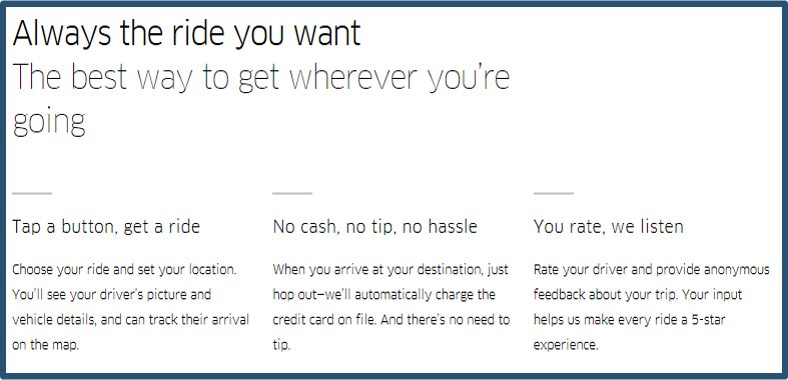It’s about a 4 min. read.
The Uber experience continues to fascinate me with each ride. I pepper my drivers with questions about Uber’s business model, their experience as a driver, and how satisfied they are driving for the sometimes controversial ride-share company. It’s a topic I also bring up around friends, family, and colleagues, and I always come back to the same question: where does Uber win and lose in the minds of end-customers?
I took a look at Uber’s brand promises to see if those promises aligned with my own experiences (as well as the experiences of other people I’ve talked to.) Below, you’ll find Uber’s promises to riders:

Verdict? Uber delivers in a big way on this promise.
Verdict? Uber says there’s no need to tip, but it’s not explicitly stated that tips aren’t included in the ride cost at all. There’s a lot of confusion surrounding this issue. Since I now know that tips aren’t included, I plan on tipping my driver out of pocket, which reintroduces the problem of fumbling around in my wallet at the end of a ride. This is an issue that could make me to switch to a competitor (perhaps Lyft, which allows you to tip in the app). In my opinion, Uber owes its drivers (aka “partners”) and its customers clarification on why “there’s no need for a tip.”
Verdict? I’m mixed. I’m still not convinced that Uber is any more or less safe than its alternatives. However, as a data nerd, I do appreciate having data on my driver when I request a ride.
Uber filled a much needed void when it launched in 2009. But as the company continues to grow, the promises it makes to customers don’t always ring true. The fix? Implementing a customer measurement system, which will ensure that the company delivers on these brand promises and doesn’t steer off the road of success.
Are you following us on Twitter? If not, come join the party!
Follow Us @cmbinfo!